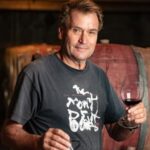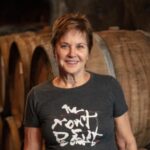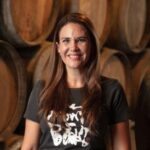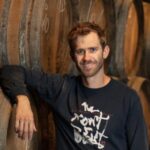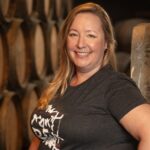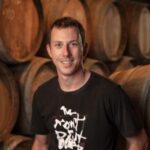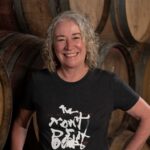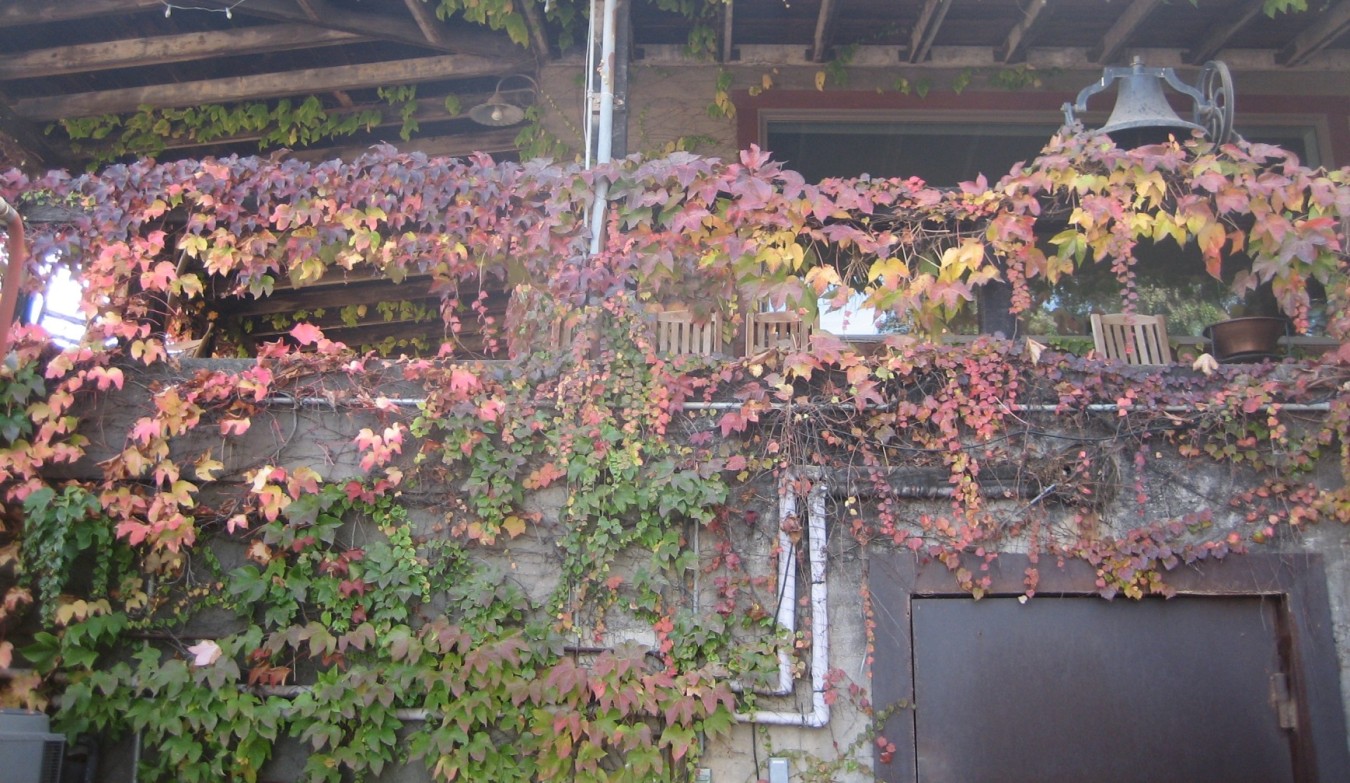Who We Are
Mount Eden Vineyards is a small historic wine estate perched at 2000 feet overlooking Silicon Valley in the Santa Cruz Mountain Appellation, about 50 miles south of San Francisco. Founded in 1945, it is recognized as one of the original “boutique” California winery properties, focusing on small lots of Pinot Noir, Chardonnay and Cabernet Sauvignon. Mount Eden’s lineage of estate bottled Chardonnay and Pinot Noir is the longest in California. Planted in austere, infertile Franciscan shale on a cool, exposed mountaintop, these low-yielding estate vineyards have consistently produced world-class wines for over a half-century. In 2007 Mount Eden acquired an additional 55 acre wine estate in the Saratoga foothills, which was christened Domaine Eden.
Mount Eden Vineyards also produces non-estate Chardonnays from the central coast, primarily Edna Valley. They have great success making Chardonnay from the Wolff Vineyard and are continually recognized as making outstanding wines from that region.
Since 1981 Jeffrey Patterson has guided the winemaking and grape growing at Mount Eden. His emphasis is on wine growing rather than winemaking; and an obsession with gentleness and naturalness in the handling of the grapes and wines is his ongoing passion.
History
Paul Masson and Martin Ray
Paul Masson, who grew up in Burgundy, set out for California in 1878 at the age of 19. He stayed for several years in northern California, settling in the Santa Clara Valley until his money ran out. Returning home and finishing college at the Sorbonne, he begged his parents to let him return to California to seek his fortune as a winemaker. This was a big step for a young man from rural France and a reflection on an adventurous time in the world; a time of reinvention when the vines of his beloved Burgundy were dying from the root louse phylloxera.
His karma was indeed blessed, for soon after arriving in San Jose, he reconnected with Charles LeFranc, the owner of the Almaden Vineyard and Wine Company, and became his winemaker and son-in-law. Misfortune happened, however, two months after his marriage to Louise LeFranc when Charles was fatally injured in a horse and buggy accident, and Paul was thrust into an ownership role of Almaden. As the 1890s progressed, Paul became less motivated by being a principal of Almaden and dreamed of owning his own wine estate.
In early 1900 Masson realized his goal and purchased 573 acres in Saratoga, California, which he named La Cresta. He set about to plant 60 acres to mainly Pinot Noir and Chardonnay with cuttings from Burgundy, probably from the vineyards of his friend, Louis Latour. His singular emphasis became sparkling wine. This was a time in America when serious méthode traditionalle was rare, especially when it was made from the classic varieties Pinot Noir and Chardonnay, which were very hard to grow and very low yielding. The Paul Masson Champagne Company was born.
Starting with the initial harvest of 1905, Paul proved that he was a good winemaker and good promoter too. Success was in his future in these remote and rugged mountains. Alas, a mere 16 years later the scourge of Prohibition shut the doors on commercial winemaking in America. Masson eked out an existence by whatever means possible, keeping the vineyards going and selling sacramental wine to the Catholic Church. The long 13 year haul was devastating to the true wine people of California who saw wine as a part of normal, civilized life. Emerging from that struggle, Paul was in his mid-70s and decided to sell his wine business.
Martin Ray, who grew up near Masson’s property, often watched the vineyard workers tending the vines. Over time, he met Paul and a casual friendship grew. Paul had great affection for Martin, as he had no sons of his own, and allowed him to work in the cellar and learn the art of making fine wine. This was pivotal to Mount Eden’s evolution.
In 1936 Prohibition was over and The Paul Masson Champagne Company was for sale. Martin, a stockbroker at the time, had recently suffered a nervous breakdown and was encouraged by his doctor and wife Elsie to change careers. He remembered fondly his days up at the Masson vineyard and decided to try and buy the property. Initially, Paul said no and suggested that a better idea was to buy the mountaintop next door to the north (Mount Eden) and establish a new vineyard and winery. Not to be dissuaded, Martin stubbornly decided to buy the Masson vineyards anyway.
A mere six years later, after operating The Paul Masson Champagne Company and eventually selling the property to the corporate conglomerate Seagram’s, he took Paul’s advice.
1940's
Martin purchased the first parcel of the mountaintop, now the site of Mount Eden Vineyards, in 1943 and proceeded to plant Pinot Noir and Chardonnay vines with cuttings from Paul Masson’s La Cresta vineyard. He was a maverick in every sense: Small production, involvement in every aspect of winegrowing, lofty prices, and lengthy dinner parties featuring his wines with the finest Burgundies available. He named his wine estate Martin Ray.
The work was arduous, especially since the vineyards were 2,000 feet above the Santa Clara Valley, up a rough two mile dirt road. Many farming advances that we take for granted today were not yet developed. Yet Ray endured, believing in the noble effort to create something unique and delicious. He was an outspoken advocate of making pure varietal wine at a time when blending was common. A passionate believer that California could make world-class wines, Ray was a wine pioneer if ever there ever one.
1950's
By the beginning of this decade Martin Ray was well on his way to realizing his dreams but suddenly, in 1951, his wife Elsie was diagnosed with cancer and quickly passed away. Ray was devastated. Fortunately, his long-time college friend Eleanor Kamb, who had always loved Martin, came to his rescue, and within a few months they married. On the peak of Mount Eden they built their residence with a cellar underneath. Surrounding the house were 3 acres of Pinot Noir, 7 acres of Chardonnay, and 1 acre of Cabernet Sauvignon. Ray expanded the vineyard acreage slowly including 3 acres of Cabernet Sauvignon on the lower elevations using cuttings from Emmett Rixford’s La Questa Vineyard in Woodside. Martin bottled all his wines at that time in Champagne bottles, complete with Champagne corks and wire hood. He nailed them shut in a mahogany box. They were packaged to cellar like mint coins.
1960's
This was the last full decade Ray was to produce wine on the mountaintop estate he created. In the early 1960s Martin established a partnership to develop more vineyards and built a new residence for its members. Given Martin’s autocratic style and emotional fragility, this proved to be a fatal mistake for him and his family. It’s ironic that just as California was emerging from the doldrums of making ordinary table wine for the masses and was beginning to realize its potential for greatness, that Martin, the sole voice in the wilderness for quality and prestige, was failing in his partnership.
1970's
Martin Ray lost his property to his investors in 1970 and ended up living the last years of his life on a small parcel below the estate vineyards in the concrete residence he built for the partnership.
In 1972 the estate was renamed Mount Eden Vineyards and the partners set out to make profound Chardonnay, Pinot Noir and Cabernet Sauvignon by hiring as a consultant the well-known winemaker Richard Graff, founder of Chalone in the Pinnacles area of Monterey. After the stunning 1972 and 1973 vintages, they hired the now-iconic Merry Edwards who produced the wines from 1974-1976. The late 70s were a mixed-bag of short term winemakers although Graff continued to steer them as best he could. An additional non-estate Chardonnay program was developed since the estate production of all three varietals combined was under 1,000 cases. For sixteen years the non-estate label was called M.E.V. due to a legal agreement with Villa Mt. Eden. (In 1988 the non-estate chardonnay was finally labeled as Mount Eden Vineyards and the M.E.V. label was dropped.)
1980's
The modern era of Mount Eden Vineyards came about unexpectedly with Jeffrey Patterson being hired as the assistant winemaker in 1981. Having graduated in biology from UC Berkeley in 1975, Jeffrey was fortunate to have been in Berkeley in the 1970s when food and wine were becoming relevant. Chez Panisse and Kermit Lynch had just opened their doors, and there was a buzz about local food and French wine. He fell in love with wine and cooking while working in Bay Area restaurants, and in 1979, he enrolled at UC Davis as a full-time concurrent student taking enology and viticulture classes.
In 1980, Jeffrey married Ellie Davis and they went for a three week honeymoon in France where they ate in as many 3 star restaurants as they could digest and visited their favorite iconic French producers: Krug, Domaine Dujac, and Domaine Leflaive.
In 1981 Mount Eden’s general manager, Fred Peterson, was looking to hire someone to help in the cellar. Jeffrey had visited Mount Eden as a wine enthusiast in 1978 and knew of the pedigree of this unique site. So in August, Patterson, at the age of 29, came on board to assist and learn. He and Ellie moved into the cottage built by Martin Ray in the 1940s.
Unfortunately, Mount Eden had been struggling financially for many years, and in December 1982 the shareholders fired Chalone, who had been recently hired to be the management company and became wholly independent. In January 1983 they promoted Jeffrey to winemaker and hired Ellie to handle the finances and marketing. The shareholders liked the idea of a young entrepreneurial couple in love with the romance of creating wine on a lonely mountain top.
Slowly, Jeffrey started to develop his craft while being respectful of the traditions surrounding these exceptional vineyards. The evolving art of winemaking in California throughout the 1980s was significant. California wine was now not just a commodity but was something special, to be collected, aged and enjoyed as a classic. This was Martin Ray’s dream.
Beginning in 1984, and over the next four years, Patterson began the arduous process of replanting some of the Cabernet and Chardonnay vineyards on the mountain. The reality of the original Martin Ray vineyards was that they yielded a scant half ton per acre and were not productive enough. The viticultural world had not only changed since Ray’s time, it had transformed. New methods of trellising allowed for closer vine spacing and better canopy management resulting in higher quality fruit and more of it.
Patterson’s winemaking style in the 1980s was a decade of experimentation, attempting to go to a leaner, high acid style like the French wines he enjoyed. He soon learned, however, that that style was not successful with this terroir-driven site.
By 1986 the company went through a financial reorganization that allowed the Pattersons to invest as minority shareholders.
1990's
Starting in 1990, there were an amazing string of great vintages. Patterson had come into his own vision and felt now, after a decade, that he knew how to grow the grapes and make the wine to reflect this amazing property. The company was now on a stable footing and he could focus on creating wines of nuance, longevity, and character.
During the 1990s the company built a 4,300 square foot wine cave, rebuilt the water system, remodeled Martin’s old garage into an office space, and replanted almost all of the Chardonnay and Pinot Noir vineyards. The experience gleaned from the plantings in 1980s, along with advancements in the whole grape growing industry, helped immensely. The winemaking, however, was still a work in progress. Although the fruit was full of potential, Patterson was still polishing his vision of ultimate perfection.
2000's
By the beginning of this decade all of the vineyards had been replanted and designed by Patterson for sixty years of production. There were now 7 acres of Pinot Noir, 20 acres of Chardonnay and 13 acres of Bordeaux varieties: Cabernet Sauvignon, Merlot, and Cabernet Franc. Patterson’s winemaking goals had not changed; with continued emphasis on balance, length of flavor and rewarding longevity. What did change, however, were the yields from the new vines which gave him more to work with. This allowed Mount Eden to start a new tier of wines called Saratoga Cuvée.
The first Saratoga Cuvée wine was from Cabernet Sauvignon grown at a local vineyard in Saratoga. Every year thereafter other local vineyards were added into the blend, along with small lots of estate fruit. All the vineyards were farmed according to Patterson’s exacting standards and yields kept low to optimize their unique expression
In 2004 Jeffrey began making two Chardonnays from the estate vineyards: the more fruit- forward lots going into the Saratoga Cuvée wine and the more tightly wound, rich and nuanced lots going into the estate bottling. This change catapulted the Estate Chardonnay, Mount Eden’s flagship wine, to be recognized as one of the California’s top Chardonnays on a consistent basis. The Wine Spectator named Mount Eden Estate Chardonnay on of its Top 100 Wines of the Year five times in seven vintages: 2004 (#13), 2006 (#11), 2008 (#13), 2009 (#26) and 2011 (#11)
Similarly with the Pinot Noir, certain lots of estate fruit, along with two new vineyards in Santa Cruz and Woodside, were designated Saratoga Cuvée.
Late in 2007 Mount Eden acquired the former Cinnabar wine estate which was located up another 2 mile dirt road on a neighboring mountaintop above Saratoga. This beautiful property, developed in 1983 by Tom Mudd, was a godsend to Mount Eden. Three cut-and-cover caves and a modern tank room gave Patterson the ability to produce the mountain-centric wines to reflect the mid-appellation of the Santa Cruz Mountains. The property was renamed Domaine Eden.
Twelve acres were already planted to Pinot Noir and Chardonnay, including a small block of Cabernet Sauvignon. The wines formerly called Saratoga Cuvée now became Domaine Eden sharing the design of the estate label. The current Domaine Eden Cabernet Sauvignon continues to be an appellation wine using four vineyards in and around Saratoga, as well as some estate grown Merlot and the Cabernet from Domaine Eden.
For thirty years the Pattersons slowly acquired more shares in the winery and in 2008 Jeffrey and Ellie had an opportunity to become the majority shareholder which ensures that Mount Eden Vineyards will continue as a family-run wine estate.
2010's
The goal of this decade is to see that the Mount Eden estate wines continue to gain prestige and world-wide acclaim.
Beyond this, Patterson views the Domaine Eden portfolio as a vehicle for creating delicious wines that are accessible to a wider audience and reflect his balanced approach. His efforts are to complete planting the approximately 12 remaining fallow acres at Domaine Eden. Planting slowly, acre by acre, over many years, learning by experience and evaluating the wines quality from the new plantings insure success. Great wines are produced 90% in the vineyard and this glacial pace of development is the only way. Patterson’s view is that a vineyard should be productive for 100 years if done well, therefore the choice of rootstock, scion, trellis and density are fundamental.
Legacy
“Martin’s only mentor was this old-world Frenchman, Paul Masson. Wine in his world was not as it is today. Wine was fundamental, sometimes great, sometimes not-so-great. Paul Masson once said, ‘I don’t care how a wine tastes, I care about how a wine drinks.’ The meaning is that the last glass is the best glass – that wine should evolve over the course of an evening. This is meaningful because wine criticism today is only a brief sniff-sip-spit regimen. One cannot truly appreciate a wine’s true qualities and future potential without spending an evening with it. “
Jeffrey Patterson, Winemaker, Mount Eden Vineyards
*************************
“This paradisiacal site, so isolated from all the bustle below, resists any winemaker’s attempt to impose rather than invoke character, and its history bespeaks a long legacy of distinctive vintages…While the wines may have changed stylistically, they always have been inspired more by personal, artistic ambitions than overtly commercial ones. That makes Mount Eden the quintessential California boutique winery, meaning not simply a small facility, but one in which wine is an avocation not a trade. Patterson and his wife Ellie have made their home on this ridge for [over] twenty-five years…..For them, as for Paul Masson and Martin Ray, wine at Mount Eden is a labor of love and a way of life.”
Paul Lukacs, The Great Wines of America
*************************
“This iconic winery continues to offer wines with personalities and styles that set them apart (especially the Estate wines) from just about anything else readers will taste from California.”
Robert Parker Jr’s. Wine Advocate December 2009
*************************
“Mount Eden Vineyards… is an almost forgotten treasure. One of the most historical wine places in California, it…..became one of the best-known vineyards in the United States for outstanding varietal wines from grapes like Chardonnay and Pinot Noir, at a time when most American wines were field blends. Today, without reaching for the spotlight, Patterson still crafts wonderful wines in a classic style and prices them far lower than what comparable wines from other regions bring. I have drunk forty-year-old Pinot Noirs from this property that were positively extraordinary, and the Cabernets are even better.”
Rajat Parr, Secrets of the Sommelier 2010
Philosophy
Winemaking is simple in its basic process. In fact, it is the natural decomposition of the grapes. Yet on the way to fine wine, it can get very complex. Wine, at its essence, is a snapshot of the ecology of the vineyard. By the ecology I mean the slope, soil, exposure, wind, sun, grape variety, and weather that particular year. At Mount Eden every bottle is a succinct expression of the vineyard’s ecology. Year in and year out we produce wines from the same vines, in the same cellars, by the same people. With that purity of expression comes a true “vineyard wine”. This is so even with our non-estate Chardonnay from the Wolff Vineyard in Edna Valley.
Most large commercial wines in the marketplace are blends from several vineyards and are what I call “winemaker wines”, meaning the composition and harmony are built by the palate and pocketbook of the winemaker. “Vineyard wines” differ in their basic approach and are usually very small in volume. I know it’s a well-worn cliché, but I do believe that all great wines are “made in the vineyard”. Therefore, over the years I have found myself working in my vineyards more and more. The connection to the estate vineyards and my influence over the quality of the fruit is my biggest satisfaction.
Not to say that the wine cellar is not important or satisfying, but the challenge and creativity is greatest in the vineyard. There is also a larger legacy left in the vineyard operations. The overall design and health of the vineyards that I will leave my successor one day will be the best possible, and I take a lot of pride in that. In the winemaking arena the approach has always been to let the wine and the vintage speak for itself. A gentle handling of the fruit, no pumping for instance, is the first step, as well as careful monitoring of the fermentations using natural yeast populations. Like an airline pilot, I intervene only when necessary, guiding the process and being there should any unexpected turbulence occur.
The human factor in any vintage is significant. For instance, harvest parameters and subsequent wine style, method of fermentation, type and age of barrels used, length of aging cycle, how one finishes the wine (whether or not to filter) are all important and are totally in the hands and head of the winemaker. Experience is a great help, and I am fortunate to have spent my entire career here at Mount Eden. The style of our wines are for a select few who typically have a long and wide wine-drinking history. Our customers are able to appreciate the intensity of character and purity of the terroir because of this.
Fine wine should be fun and delicious. Whether with food or without, it shouldn’t be too serious or pretentious, yet it often is. I try in my public persona to communicate this levity and hedonism whenever possible.
Jeffrey Patterson, Winemaker
Our Team
Jeffrey Patterson
A native Californian, Jeffrey Patterson graduated from U.C. Berkeley in 1975 with a degree in biology. While in Berkeley, he witnessed and participated in the emergence of northern California’s fine wine and food culture. An enthusiastic wine drinker and collector, Jeffrey decided to pursue a career in the wine business and, in 1979, enrolled in the U.C. Davis viticulture and enology program, where he studied for two years.
In 1981, Patterson became assistant winemaker at Mount Eden Vineyards. He had visited the Santa Cruz Mountain winery in 1978 and believed Mount Eden, with its long history of fine wine production, would be an ideal place to practice his craft.
Jeffrey and his wife Ellie left Berkeley to begin a new life 2,000 feet above the Santa Clara Valley. A little over a year after his arrival, Patterson was promoted to head winemaker and general manager, and Ellie became the winery’s business manager. In 1986, they became significant shareholders in the company and, in 2008, the Patterson’s acquired the majority of the ownership with their two children, Sophie and Reid.
Today, with over 40 years of experience at California’s original boutique winery, Jeffrey continues to live in the house Martin Ray built on Mount Eden in the early 1950s, surrounded by the winery’s historic estate vineyard and a panoramic view of the now-famous Silicon Valley. He enjoys cooking for friends, playing tennis and being a grandfather.
Ellie Davis Patterson
Ellie grew up in southern California and moved to the Bay Area in 1973. After graduating from U.C. Berkeley with a degree in history in 1976, she returned to school to study ornamental horticulture and worked for the UC Berkeley Botanical Garden writing educational material. She also studied textile arts and became a handweaver. Ellie met Jeffrey Patterson in 1978; they were married in 1980. After Jeffrey finished taking classes at UC Davis, they moved to Mount Eden, where she continued her textile arts until 1983, when she became the business manager at Mount Eden when Jeffrey was promoted to head winemaker.
After 40 years, Ellie is semi-retired and living in San Luis Obispo. She continues to guide the finance and marketing of both Mount Eden and Domaine Eden.
Sophie Patterson Sharabi
Jeffrey and Ellie’s daughter, Sophie, grew up amongst the vines of Mount Eden.
Moving to San Francisco, she attended The University of San Francisco, where she studied nursing. In 2007 when Mount Eden began a partnership with Press Club, a joint tasting room, she managed the Mount Eden staff while also pursuing her passion for helping others as a registered nurse.
Inspired by her parents’ entrepreneurial spirit, she founded a fertility nursing service, which has grown into a thriving business. However, when Sophie became a mother herself, she felt a draw to put her hosting and event planning skills to work back at Mount Eden. Sophie now lives in Los Gatos, with her husband Daniel and their daughter Eden—named after her former mountaintop home.
As our Director of Hospitality, Sophie handles everything from winery tours to private events. She is delighted to educate wine enthusiasts about the fascinating history of Mount Eden and is excited to be the next generation of Mount Eden’s future.
Reid Patterson
Reid Patterson is Jeffrey and Ellie’s son, born and raised on the mountain-top.
Growing up here, Reid says he “always felt the pressure to make Mount Eden his career” and initially resisted the idea.
After studying chemistry and dabbling with another specialty beverage, coffee, he realized that Mount Eden is genuinely home and where he needs to be—returning at the end of 2017. With Jeffrey, as a mentor for farming and winemaking, Reid has taken on the role of Assistant General Manager, learning all aspects of the wine industry. With a particular interest in viticulture, Reid embraces the unique challenges each season brings to the vineyards.
The return was meant to be, and Reid is excited to continue the family legacy with his sister Sophie.
Andrea Kyle
Andrea Kyle joined Mount Eden Vineyards in 2000 and is a vital part of the business team as Director of Operations. Born and raised in Illinois, she earned a BA in English Literature from Loras College in Dubuque, IA, where she began her love affair with wine. In 2009 she became a Certified Sommelier and in 2013 a Certified Specialist of Wine.
Andrea lives in San Jose with her husband and dog. She enjoys cooking, traveling, and of course, wine.
Austin Chin
Our Assistant Winemaker, Austin Chin, is a San Francisco Bay Area native, born and raised in Concord, CA. His passion for wine began when attending Cal Poly, San Luis Obispo, where, after switching majors, he obtained a BS in Wine and Viticulture (2014).
After graduation, Austin cut his teeth in the fine wine industry, working for multiple labels up and down the Central Coast of California. After “showing up” at Mount Eden Vineyards in late 2016, he was offered a cellar/vineyard position and has not looked back. His role at Mount Eden has evolved since being promoted to assistant winemaker in 2018. He manages the crush pad during harvest and runs the bottling line in the spring, but most days are spent working side-by-side with the vineyard crew.
Outside of work, Austin enjoys skiing, fly fishing, spending time with family, and wine.
Michele Duckett
Michele Duckett is the newest member of our Mount Eden Team, joining us in 2019 as our Sales Director. A longtime resident of North Carolina, her passion for wine was sparked working in restaurants while earning a BA in English at Appalachian State University in Boone, NC. Her plans for graduate school shifted when she landed the job as General Manager of a top NC restaurant with one of the best wine lists in the state.
The wine bug had bitten.
She soon began an 8-year stint as the Western Regional Sales Manager for a Carolina based boutique wine wholesaler. This prepared her for her next tenure: 14 years as National Sales Director for Elyse, a small family-owned Napa Valley winery. When the owners opted to sell in 2018, she decided it was time to pursue a dream – “I have always been a huge fan of the Mount Eden wines, having sold them in both my restaurant and distributor days. I truly feel so fortunate to work with the Pattersons and to represent this iconic, historic winery and its extraordinary wines.”
Region and Climate
Mount Eden’s larger home is the Santa Cruz Mountain Appellation. It is American’s first mountain AVA—recognized in 1981—with winegrowing dating back to the 1860’s. The appellation encompasses the Santa Cruz Mountain range, with boundaries defined by the elevation of the fog levels at daybreak in the spring and summer months, typically, between 600 to 1000 feet. Those vineyards above the fog are dryer and see abundant sunlight; while below this line vineyards are compromised by the cooler moist conditions. Mount Eden’s estate vineyards are at 2,000 feet.
In California, winegrowing climates are controlled primarily by the Pacific Ocean—the closer a vineyard is to the coast, the cooler the daytime high will be. This is important in giving the vines an even and slow ripening environment, especially with the sensitive French varietals grown at Mount Eden. Being high in the mountains, close to the ocean and the San Francisco Bay allows ideal, long, fog-free days with low daytime highs and a relative absence of heat spikes in the summer and fall.
In addition, most of the acres farmed here are on eastern slopes. This direction gives the estate vineyards an incidence to the sun which promotes this desired slow, measured ripening.
The combination of elevation, which keeps the vineyards free of fog and frost, California’s Mediterranean climate, and sufficient rainfall in the winter, allows Mount Eden to dry-farm the vineyards to produce superb fruit year after year.
FAQ
- Why Does the Mount Eden Chardonnay age for so long?
The synergy of the vine selection, soil, low yields, climate and minimalist handling of the wine in the cellar creates chardonnays that age eight to ten years consistently.
- Who owns Martin Ray brand today?
Martin Ray started vineyards on our mountaintop in 1942. He was the proprietor for thirty years under the Martin Ray label. Martin Ray died in 1976 and after his death, his stepson Peter Martin Ray and partners went into business resurrecting the Martin Ray brand. They purchased grapes mainly from Napa and Sonoma until 1984. They sold the name Martin Ray to Courtney Benham in 1990 and since 2003 the current Martin Ray Winery has made its home in the Russian River Valley, California. There is no longer a connection to the historic Martin Ray brand of old and the current Martin Ray brand. Mount Eden Vineyards has been growing grapes and making wine on the former Martin Ray estate since 1972.
- What is the difference between Villa Mt. Eden and Mount Eden Vineyards?
Villa Mt. Eden is a large winery located on the valley floor in Napa. Grapes for this winery are purchased from all over California. It is one of a portfolio of wineries owned by Stimson Lane, who also owns Conn Creek, Columbia Crest, Chateau Ste. Michelle, Col Solare, Domaine Ste. Michelle, Northstar, Red Diamond, Snoqualmie and Stimson Estate Cellars.
Mount Eden Vineyards is a 60-year-old fine wine estate located 2000 feet above the Santa Clara Valley adjacent to a geographical Mount Eden in the Santa Cruz Mountains. As one of the oldest continuous producers of estate bottled Pinot Noir and Chardonnay in California, it is run with the care of a family-owned business. Due to trademark agreement the “ Mt.” in Villa Mt. Eden must always be abbreviated and the “Mount” in Mount Eden Vineyards must always be written out and never abbreviated.
